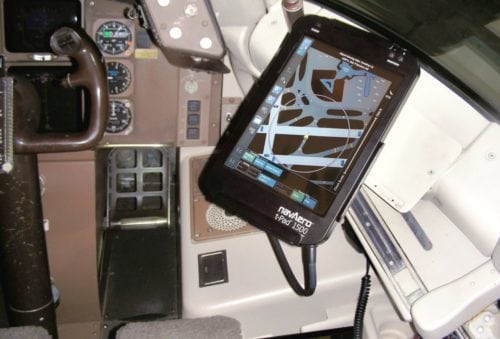
Image courtesy of Jeppesen
In October, the FAA published new guidance concerning electronic flight bag (EFB) applications. An updated Advisory Circular (AC) has been issued for aircraft system designers, installers and operators who may want guidance for hosting EFB applications on portable devices and installed equipment.
Unlike the last guidance issued in May 2014, this circular offers new applications and the ability to manage EFB programs with “significantly less FAA involvement,” the agency said. The FAA said it worked closely with industry, other regulatory authorities and the ICAO Operations Panel to harmonize EFB guidance. All guidance associated with EFB classification has been eliminated in the new policy. The circular also clarifies the definition of “EFB” and reorganization EFB application software types according to safety importance.
In this new circular, the FAA has obliged to requested changes from aviation stakeholders. The FAA is removing its previous prohibition on the display of aircraft location during flight on various EFB applications. This function was available only on the ground. Stakeholders also asked for the ability to make some day-to-day changes to EFB applications without having to contact their FAA principal inspectors. This is now permitted for many of the day-to-day modifications.
The new AC, though, is just the latest example of how the use of EFBs is continually evolving in flight operations.
Just a few years ago, pilots carried flight bags filled with paper charts and manuals. Initial EASA and FAA guidance categorized EFBs as Class 1 (portable), Class 2 (mounted) or Class 3 (installed).
Then came the iPad, which changed everything. Being low cost, high performing, intuitive, compact, mobile and easily acquired and upgraded, the iPad and later the Surface tablets offered many advantages never seen before. Within a few years, tablet EFB programs accounted for the majority of new program authorizations, and have today become the go-to solution for most airline carriers.
The speed and widespread adoption of EFB using commercial-off-the-shelf (COTS) devices has been breathtaking. There has also been tremendous growth in associated mobile applications and their capabilities. Finally, connectivity options and declining costs have opened many new frontiers inconceivable or unaffordable just a few years ago. Initial uses include graphical in-flight weather, turbulence avoidance, optimized flight tracks and profiles, company communications and more. Many of the emerging FAA NextGen and Eurocontrol SESAR initiatives, including 4-D trajectories and free flight, will require broadband connectivity to be cost-effective and achievable.
While tablet EFBs have made enormous strides, and continue to do so, there are limits to what these tablets can accomplish or be legally allowed to execute. They cannot be relied upon to operate or navigate an airplane — only certified avionics can. Tablet EFBs are COTS devices and as such are not certified the way the airplane’s avionics are. Avionics must pass rigorous testing standards, such as RTCA DO-160: Environmental Conditions and Test Procedures for Airborne Equipment, to be certified and legal as airworthy equipment before they can ever be installed in an airplane.
There are also aircraft design and architecture considerations that limit the ultimate uses of COTS EFB devices. ARINC Specification 664P5: Aircraft Data Network Part 5 Network Domain Characteristics and Interconnection and ARINC Report 821: Aircraft Network Server System (NSS) Functional Definition clearly define different domains on the aircraft and what types of functions they can undertake. The aircraft control domain is intentionally segregated, closed and independent of all others. Only certified avionics can be utilized there.
According to a presentation given at Avionics for NextGen 2017 on current and future use of EFBs given by Biruk Abraham, an operations research analyst at the FAA, the internet of things (IOT) and System Wide Information Management is also driving new usage of EFBs.
One of the new uses of EFBs that Abraham discussed was the use of tablets by pilots for the SWIM Terminal Data Distribution System (STDDS), which the FAA notes is capable of converting raw surface data collected from Terminal Radar Approach Control (TRACON) facilities into easily accessible information. The information is published and made accessible via the National Airspace System (NAS) Enterprise Messaging Service (NEMS). A potential use of STDDS is to overlay the status of other aircraft on or moving toward active runways.
“If you address the quality and certification requirements that are necessary to make use of this information, you can potentially use that as a source of information to overlay into your EFB,” said Abraham.
Moving forward, the industry forum that will continue to drive new usage of EFBs is the EFB Users Forum, which just met in Singapore.
“Presently, the EFB Subcommittee is updating ARINC Specification 840 for use in the tablet environment most airlines operate with today. The goal is that the user will have single sign-on and data entry, along with seamless navigation between the myriad of applications available today,” the forum committee leaders noted in the most recent issue of Avionics.